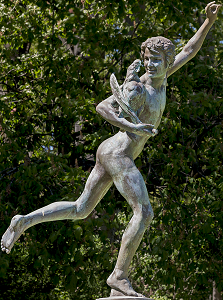
Site Introduction | Art Gallery Index
Falguière and Moulin Page | Moulin Page | View Pictures
| Cock Fighting | Dancing for Joy |  |  |  |  |  |  |
![]() Alexandre Falguière
Alexandre Falguière
(1831-1900)
Winner of the Cockfight and other works
Short Biography (French) | Short Biography (rough English translation)
Falguière’s Cockfight: full size versions | Falguière’s Cockfight: statuette versions
Women with Bows | Women with Birds | Falguière Memorial | Other Cockfights in Art
Falguière’s Winner of the Cockfight is featured in my adult story “The Here and Now”.
Do not follow this link if you find sexual content offensive.
JEAN-ALEXANDRE FALGUIÈRE
Born: Toulouse, 1831. Died: Paris, 1900
While searching for biographical information on Falguière, I came across the following:
Après des études dans sa ville natale, ce sculpteur, d’origine modeste, vint à Paris où il fréquenta l’école des beaux-arts et travailla notamment dans l’atelier de Carrier-Belleuse. Grand prix de Rome en 1859, il participa régulièrement aux salons où il triompha en 1868 avec Tarcisius, martyr chrétien (acquis par l’État). Il sut adapter son talent vigoureux aux goûts du public et des élites de son temps, ce qui lui valut de nombreuses commandes de figures historiques : Gambetta à Cahors, l’amiral Courbet à Abbeville, Armand Barbès à Carcassonne, Charcot à la Salpétrière... des œuvres qui rappellent la manière de David d’Angers. C’est vers lui que se tourna la Société des gens de lettres, mécontente du Balzac qu’elle avait commandé à Rodin. Falguière représenta l’écrivain assis ; la sculpture fut exposée au Salon de 1899. Dans un autre registre, il exécuta de gracieuses figures féminines qui lui valurent le surnom de “poète du déshabillé”.
--taken from http://www.culture.gouv.fr/culture/actualites/celebrations2000/autres.htm [a long way down the page!]
Roughly translated (this is a tidied up version of a Babelfish translation... anyone remember that?!...
with thanks to NoraPhilippe who e-mailed a couple of corrections):
After studying in his birthplace, this sculptor, of modest origins, came to Paris where he attended the School of Fine Arts and worked in particular in the workshop of Carrier-Belleuse. As a winner of the Grand Prix the Grand Prix of Rome in 1859, he took part regularly in the shows where he triumphed in 1868 with Tarcisius, Christian Martyr (acquired by the State). He could adapt his vigorous talent to the tastes of the public and the elites of his time, which won him many commissions for historical figures: Gambetta in Cahors, Admiral Courbet in Abbeville, Armand Barbès in Carcassonne, Charcot in Salpétrière... These works are reminiscent of the style of David d’Angers. The Company of Men of Letters, dissatisfied with the statue of Balzac which it had commissioned from Rodin, turned to Falguière, who represented the writer sitting; the sculpture was exhibited at the Show of 1899. In another style, he produced gracious female figures which made critics call him the “Poet of the undressed”.
Incidentally, Rodin’s Balzac, referred to above, is now regarded as a masterpiece, but in its day it was clearly too radical for some tastes.
If anyone can supply any further information on Falguière, your e-mails would be appreciated.
All images below link to bigger versions, but in some cases not as big as I would have liked.
Falguière’s Cockfight: full size version
    |
    
One of Falguière’s best-known works is probably Le Vainqueur au Combat de Coqs (The Winner of the Cockfight), which now stands alongside Moulin’s Une Trouvaille a Pompeii (A Lucky Find at Pompeii) in the Musée d’Orsay in Paris. (Moulin Page) | (Falguiere and Moulin page) Both statues depict energetic nude youths poised on one foot. In the case of Falguière's Cockfight, the boy holds his winning cockerel (the obvious bawdy pun may be intentional) in the crook of his right arm while punching the air with the left fist, and runs or dances for joy, the statue capturing the moment when his raised left leg forms a counterpoint (and of course counterbalance) to his raised arm. He might perhaps be the same boy who is depicted in the painting by Jean Léon Gérôme (see also “And speaking of cockfights...” below). Pictured above are several views of the original in the Orsay, some of which show the museum background. |
Falguière’s Cockfight: full size copy
in Jardin des Plantes, Toulouse
   | ||
     
Photos 2 - 3 above are taken from Wikimedia Commons, scaled down a little, cropped and adjusted. Photos 5 - 6 link to Flickr originals. 1 is by Sweety Trotter; 5 - 6 are by urbanman; 7 - 10 are by Pierre Beteille (Monkeyman). The full-size versions of photos 1 and 7 - 10 are apparently no longer on Flickr. Falguière’s Cockfight: statuette versions Most of Falguière’s other works seem to have been female nudes from mythology, Juno and the Peacock in Bulfinch’s Mythology Falguière Memorial
See also Jean Léon Gérôme’s painting Le Combat de Coq (The Cock Fight) (above left) and Sophie-Victoire Debry’s statue Cockfight (above right). Comment on This Page Site Introduction | Art Gallery Index | Falguière and Moulin Page | Moulin Page Return to Top of Page |


















